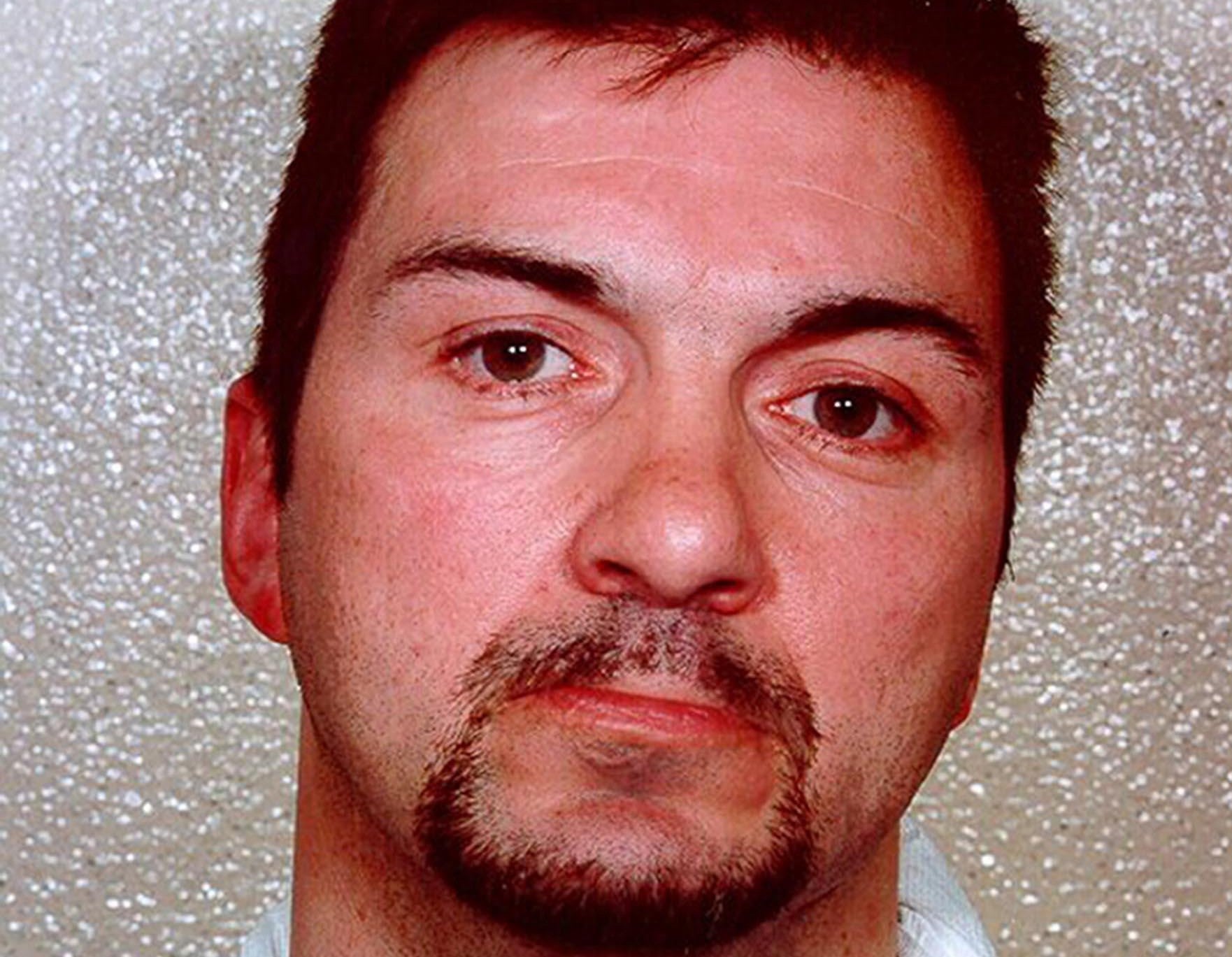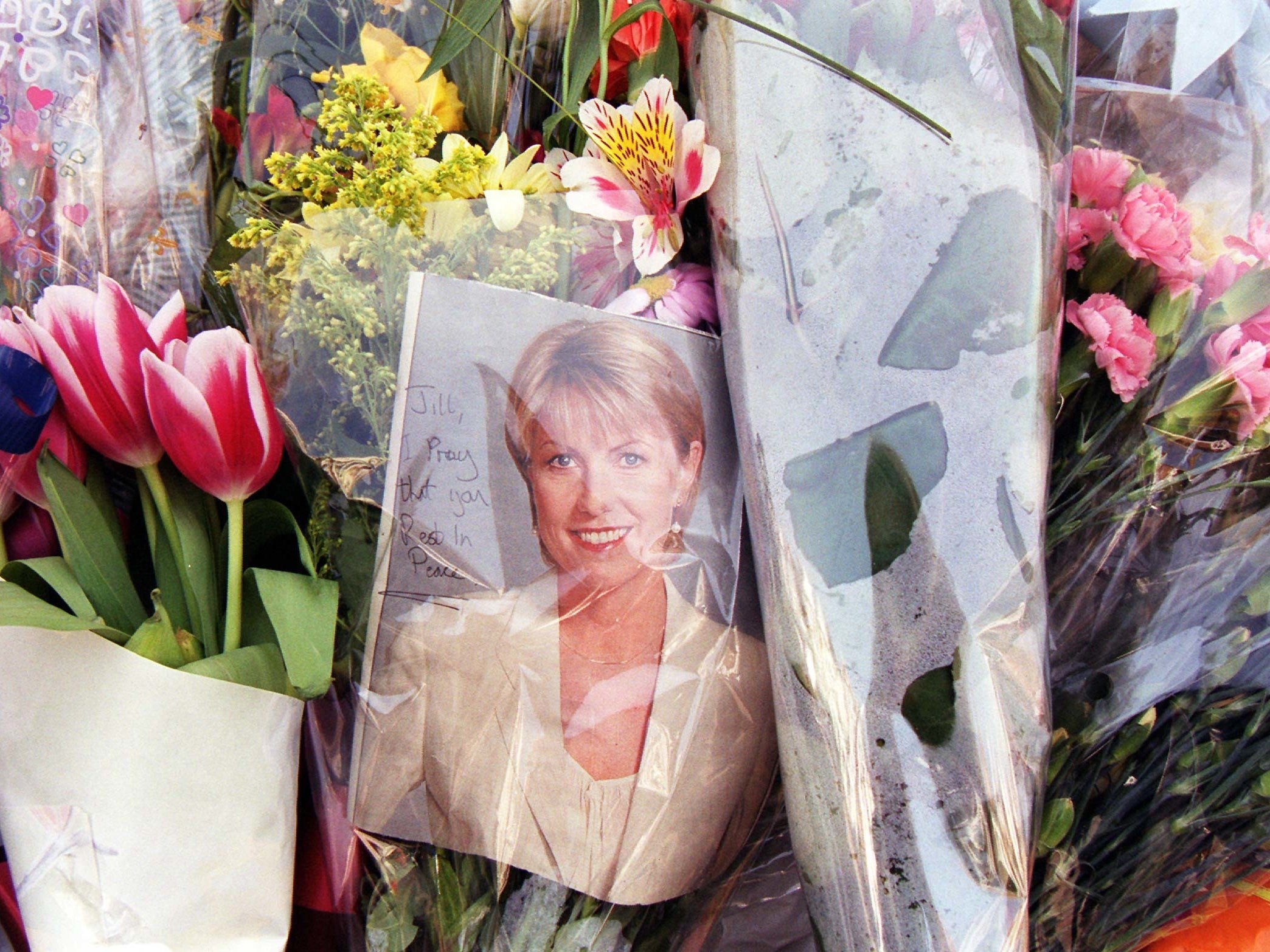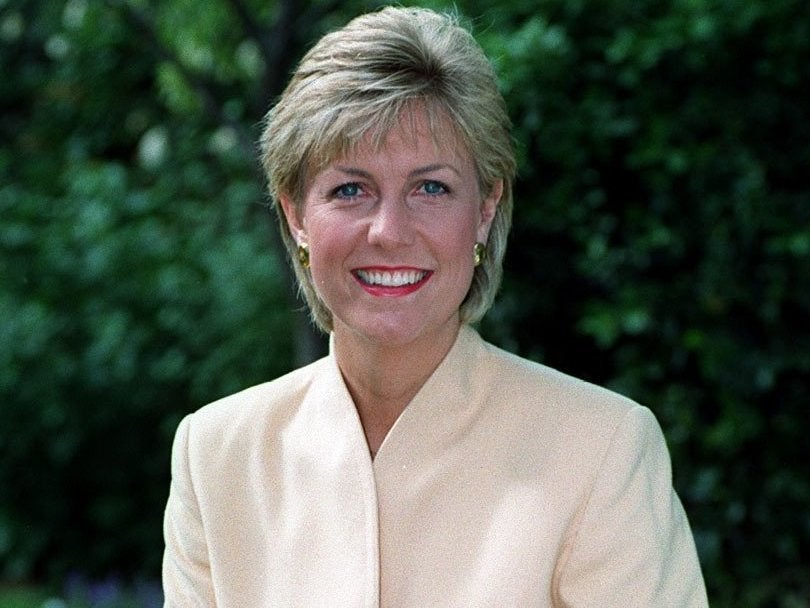
They found ‘the golden girl of British TV’ outside her front door, a single bullet wound to her head, the keys to her BMW convertible still in her hand.
The hunt for whoever killed Jill Dando would become the biggest murder inquiry conducted by the Metropolitan Police and the largest criminal investigation since the hunt for the Yorkshire Ripper.
It would involve the taking of 2,400 statements, the tracing of 1,200 cars and the investigation of 2,000 potential suspects.
There was also a trial and conviction, followed by an appeal, retrial and acquittal.
The result is that 20 years after Jill Dando was murdered on her Fulham doorstep on 26 April 1999, no-one in authority knows for sure who killed the BBC News, Crimewatch, and Holiday programme presenter.
We are left with a documentary,The Murder of Jill Dando, broadcast on BBC One earlier this month, and a whole heap of speculative theories.
Someone involved in Ms Dando’s love life
In the early stages of the murder investigation, a lot of attention – at least in media terms – fell on men who had been romantically linked to Ms Dando.
“TV’s girl next door” had lived with television producer Bob Wheaton, 14 years her senior, before the relationship ended because, according to some accounts, he tired of her frequent absences as she travelled the world on assignment for the Holiday programme.
Then there had been Simon Basil, a young South African game warden with whom Ms Dando had enjoyed what she described as a “very Lady Chatterley” relationship.
Eventually, on a blind date, she “found the man I love”, the gynaecologist, Alan Farthing. In early 1999, Ms Dando and Mr Farthing announced their engagement at a party attended by Sir Cliff Richard, Nick Ross and Anna Ford, with the first interview being secured by OK! Magazine.
But between these three publicised romances, there had been briefer flings, as police discovered when they started trawling through Ms Dando’s personal diaries.
Early on in the investigation, Detective Chief Inspector Hamish Campbell, the man leading the murder hunt, was quoted as saying: “Her career must be looked at, but I do not consider it to be of equal importance to her private life. We have many positive leads.”

But once these leads were thoroughly investigated, they turned up nothing.
All the men who had romances with Ms Dando were cleared.
So too was an allegedly besotted Russian crimelord who had been the subject of speculation that he had ordered Ms Dando’s killing because she had rejected his advances while filming for the Holiday programme in Cyprus.
The murder investigation provided a good excuse for those kinds of stories about a celebrity’s love life, but no credible evidence has ever emerged to suggest that anyone romantically linked to Ms Dando had anything to do with the murder.
The ‘local weirdo’: Barry George

Barry George, now 62, the only man ever to be put on trial for Jill Dando’s murder.
He had been named in a tip-off given to police the day after the murder, which referred to a “mentally unstable man” who lived just 500 yards from Ms Dando’s home.
Yet it took detectives ten months before they came to seriously consider him as a suspect.
One possible explanation for the delay is what had confronted those investigating the killing of one the BBC’s most popular stars: wall-to-wall media coverage producing a blizzard of tips and suggestions, only a fraction of which were useful.
When detectives did get round to giving Barry George a proper look, he started to fit the psychological profile provided in May 1999 by forensic criminal psychologist Dr Adrian West, who had urged police to look for an obsessive loner.
Mr George had previous convictions for attempted rape and indecent assault. On one occasion in the early 1980s he was found hiding in the bushes at Kensington Palace, wearing khaki, carrying a knife and a length of rope.
He was a fantasist, who had falsely claimed to be named Paul Gadd, (before the singer better known as Gary Glitter was exposed as a paedophile), or ‘Barry Bulsara, the cousin of [Queen singer] Freddy Mercury’.
He also had some experience with firearms: he spent nearly a year in the Territorial Army before being discharged in November 1982, being taught how to maintain and shoot assault rifles and machine guns.
Women complained that he had stalked them.
When police searched Mr George’s flat, they found many photographs of local women, and no fewer than four copies of the Jill Dando memorial issue of the BBC’s in-house magazine Ariel.
And in the pocket of Mr George’s overcoat, a forensic scientist found a tiny particle, which he said could be firearms residue from the gun used to kill Jill Dando.
The police were convinced they had their man. They had witness evidence placing Mr George near Ms Dando’s house on the day of the murder, they had the “repeated lies” they said Mr George told when questioned, and they had the firearms residue.
Mr George was arrested for murder, put on trial at the Old Bailey, and on 2 July 2001 found guilty by a 10-1 majority jury verdict. He was sentenced to life in prison.
But then in 2007 his conviction was quashed, and in 2008 he was cleared after a retrial.
In truth, there had always been doubts in some quarters about Mr George’s conviction.
Even some of the women who had been pestered, albeit not stalked, by Mr George doubted whether he had the intelligence to plan and execute such a seemingly clean, one-shot kill.
At his second trial, the defence produced analysis from neuropsychiatrist Professor Michael Kopelman who said Mr George had an IQ of 75, putting him in the lowest five per cent of the population.
The professor added that when it came to ability to organise himself and carry out plans, Mr George scored in the bottom one per cent for memory and “executive” tests.
By the time of the second trial, the firearms residue evidence had already been rejected. The 2007 Appeal Court hearing had been told by expert forensic science witnesses that it was “no more likely that the particle had come from a gun fired by Mr George, than that it had come from another source.”
A senior CPS official was quoted as describing how before the 2008 retrial, “We looked for any [other] show stoppers. There weren’t any.”
Barry George is now a free, innocent, but angry man.
Despite taking his case to the High Court in 2013, he has been refused any money for his erroneous conviction and years behind bars, because of laws saying compensation should only be paid when a new fact emerges to prove beyond reasonable doubt that an applicant did not commit the offence.
“How,” Mr George later asked the Daily Mail, “Can you be acquitted unanimously by judge and jury, which means you (regain) innocent status, but then get told you are not innocent enough?”

The Serb hitman
This is perhaps the most enduring theory about the Jill Dando murder.
It was being aired on the front page of at least one tabloid newspaper less than 48 hours after the presenter was killed.
At least initially, there seemed a lot of substance to the hitman theory. Ms Dando was killed by a single shot to the head, a method often considered the hallmark of a professional.
Despite Ms Dando being shot in broad daylight at about 11.30am, the killer was somehow able to slip away without being seen – something that again might suggest the work of a professional.
And then there was the coincidence that, potentially, Jill Dando had angered some very violent people who might have been able to call upon state support.
On April 6 1999, 20 days before she was killed, she had fronted a BBC Kosovo Crisis Appeal that raised more than £1m in 24 hours for those fleeing the latest round of ethnic cleansing in the Balkans.
Western involvement in the Kosovo War, involving Nato bombing of targets linked to Serb forces and their political leader Slobodan Milosevic, had already begun.

And on the night of 23-24 April 1999 – just days before Ms Dando’s murder – British and US warplanes bombed the Radio Television Serbia building in Belgrade, killing 16 of the news organisation’s employees.
The day after Ms Dando was killed, it emerged that Tony Hall, then the BBC’s head of news, now the corporation’s director general, had been phoned by a man with an East European accent saying: “Your prime minister Blair butchered innocent young people, we butcher back.”
The Serbian hitman theory would become a cornerstone of the original 2001 trial defence of Barry George.
Michael Mansfield QCtold the Old Bailey that as the face of both the Kosovo Crisis Appeal and the BBC, Ms Dando could have been been the target of a revenge killing ordered by the notorious Serbian warlord Arkan, (who had himself been assassinated in January 2000).
The prosecution at the 2001 trial, however, dismissed the Serbian hitman theory as “headline grabbing … Utter nonsense”.
And while the hitman theory still has its adherents, a number of subsequent reports have cast doubt upon it.
Detectives on the Dando investigation are said to have strongly suspected the call to Tony Hall had been a hoax.
When the Daily Mail tracked down one of the strongest candidates for the Serb hitman, he showed what he had presented to UK police who visited him in 2009: a passport with entry and exit stamps suggesting he had been in Macedonia at the time of the killing.
The Daily Mail also reported that the BBC’s veteran foreign correspondent John Simpson had been in Belgrade in 1999 and had actually met Arkan on the day Ms Dando had been killed.
If the warlord really had wanted to kill a well-known BBC figure, wouldn’t it have been far easier to have murdered the one he was meeting anyway?

The London underworld hitman
Along with the Serbian hitman theory, there have been suggestions Ms Dando was killed by a professional closer to home, in revenge for helping the police in her work as a Crimewatch presenter.
In 2015 former Surrey police detective and TV investigative journalist Mark Williams-Thomas suggested that Ms Dando had been murdered on the orders of a London underworld ‘Mr Big’ to “send out a direct, bloody message to others: ‘Do not take on organised crime’.
“Jill,” Mr Williams-Thomas added, “May have signed her own death warrant through her work on Crimewatch.”
After trawling through 52,000 documents made available to Mr George’s defence team during his second trial, Mr Williams-Thomas said he had found an intelligence report naming two London men as having acted for a major organised crime gang.
The pair were said to have broken the murder weapon into four pieces which they then dumped in a canal on their gang’s territory.
The intelligence report, however, was less than conclusive. It also stated that one of the men was subsequently identified, but detectives could find no link to the organised crime gang. The other man was seemingly never found.
There are also other reasons to be at least sceptical when it comes to all theories suggesting Ms Dando was murdered by a hitman.
It was not as if the police ever refused to consider the possibility of criminals seeking violent revenge for Ms Dando’s Crimewatch work.
During their investigation, they looked into and discounted up to 30 people with clear reason to resent Crimewatch. Convicted contract killers were also visited in jail and questioned about likely suspects before the possibility of a revenge hit was rejected by police.
Another potential problem with this hitman theory is why criminals would seek revenge on the TV presenter, when the more obvious targets would be the actual ‘grass’ or the cop who did the hard work of cracking the crime.
And outside the realm of TV and film, there has to be at least a question mark over whether a professional assassin really would be happy to assume that his first shot had killed their target.
Then there is the report prepared by the highly experienced Dr West a month after the murder.
This suggested the killing was actually not as professional as it initially seemed.
“Although the killing appears to have been carried out proficiently,” wrote Dr West, “An obvious contradiction is that the shell casing has been left at the scene. A professional who knew what he was doing would not have allowed [that to happen].”
Forensic examination of the shell casing and bullet suggested the murder weapon was something like a modified starting pistol or a reactivated firearm with a low muzzle velocity – not the kind of gun you would normally associate with a professional hitman.







